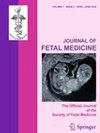宫颈长度、子宫颈前角和宫颈弹性成像与早产发生率的相关性
IF 0.2
Q4 OBSTETRICS & GYNECOLOGY
引用次数: 0
摘要
抽象目标 本研究的目的是通过常规异常扫描中经阴道超声的评估,发现宫颈长度、子宫颈前角和宫颈弹性成像与早产发生率的相关性,并分析这些参数之间的相关性。方法 对18至24周来接受异常扫描的单身孕妇进行了横断面比较研究。在矢状面中段测量子宫颈长度和子宫颈前角。应变弹性成像用于测量颈部应变。获得整个宫颈的彩色图,并记录宫颈硬度的颜色代码。后果 尽管早产组的宫颈长度平均值明显较低(3.2 cm)高于足月组(3.6 cm),大于2.5的临界值 cm,低于此值通常被认为是早产的宫颈短。早产妇女的子宫颈前角平均值明显较高(112.3 度)分娩量高于足月分娩量(82.2 度)输送。足月组(0.130)和早产组(0.179)的颈部弹性成像平均应变值存在显著差异。弹性成像的颜色编码与早产无关。宫颈长度与分娩时胎龄(GAD)呈正相关。急性子宫颈前角和GAD呈显著负相关。结论 子宫颈前角在预测早产中具有决定性作用,因此它可以与传统的宫颈长度筛查相结合,以识别宫颈长度正常、早产风险高的女性。子宫颈弹性成像评估子宫颈的一致性,也有可能识别高危女性。本文章由计算机程序翻译,如有差异,请以英文原文为准。
Correlation of Cervical Length, Anterior Uterocervical Angle, and Cervical Elastography with the Incidence of Preterm Labor
Abstract Objectives The aim of this study is to find the correlation of cervical length, anterior uterocervical angle, and cervical elastography with the incidence of preterm labor through evaluation by transvaginal ultrasonography during routine anomaly scan and to analyze the correlation of the parameters with each other. Methods Cross-sectional comparative study was undertaken on singleton pregnant women coming for anomaly scan between 18 and 24 weeks. Cervical length and anterior uterocervical angle were measured in the mid-sagittal section. Strain elastography was used for measuring cervical strain. Color map was obtained for the entire cervix and the color code for the degree of cervical stiffness was noted. Results Though the mean value of cervical length was significantly lower in preterm group (3.2 cm) than in term group (3.6 cm), it was more than the cutoff value of 2.5 cm, below which it is routinely considered as short cervix indicative of preterm labor. Mean value of anterior uterocervical angle was significantly higher in women with preterm (112.3 degrees) delivery than those with term (82.2 degrees) delivery. Mean strain values of cervical elastography were significantly different in term (0.130) and preterm groups (0.179). Color code in elastography was independent of preterm labor. There was a significant positive correlation of cervical length with gestational age at delivery (GAD). A significant negative correlation was observed between acute anterior uterocervical angle with the GAD. Conclusion Anterior uterocervical angle has a definitive role in the prediction of preterm labor and so it can be combined with the conventional cervical length screening in identifying women with normal cervical length who are at high risk of preterm labor. Cervical elastography assesses the cervical consistency and also has the potential for identifying high-risk women.
求助全文
通过发布文献求助,成功后即可免费获取论文全文。
去求助
来源期刊

Journal of Fetal Medicine
OBSTETRICS & GYNECOLOGY-
自引率
50.00%
发文量
26
期刊介绍:
Journal of Fetal Medicine is the official journal of the Society of Fetal Medicine affiliated with International Society of Ultrasound in Obstetrics & Gynecology. This is a peer-reviewed international journal featuring articles with special interest to fetal medicine specialists, geneticists and ulstrasonologists. The aim of the journal is to communicate the results of original research in the field of fetal medicine. It includes a variety of articles suitable for clinicians and scientific specialists concerned with diagnosis and therapy of fetal disorders. All articles on health promotion of the fetus are acceptable for publication. The major focus is on highlighting the work that has been carried out in India and other developing countries. It also includes articles written by experts from the West. Types of articles published: - Original research articles related to fetal care and basic research - Review articles - Consensus guidelines for diagnosis and treatment - Case reports - Images in Fetal Medicine - Brief communications
 求助内容:
求助内容: 应助结果提醒方式:
应助结果提醒方式:


